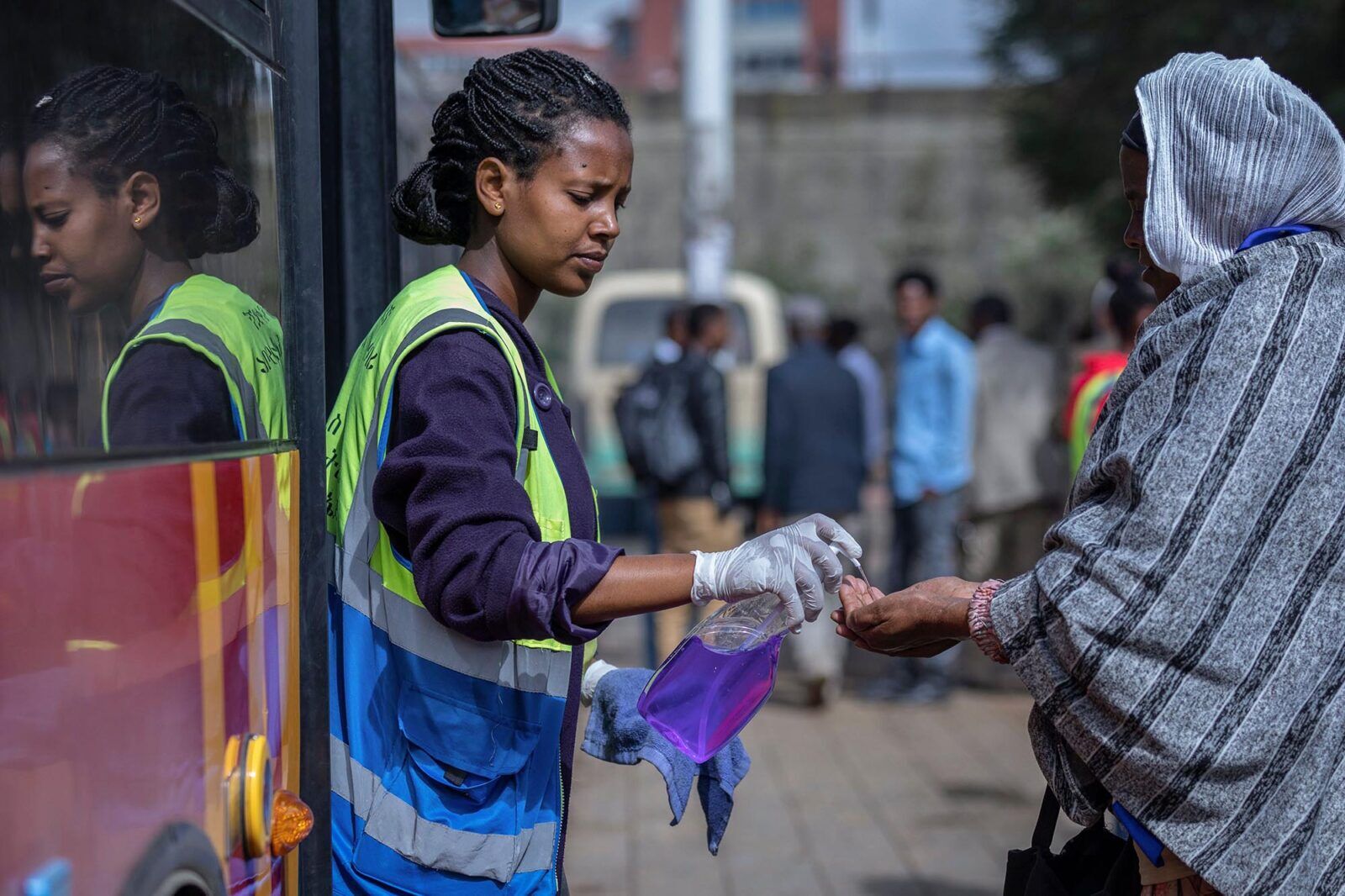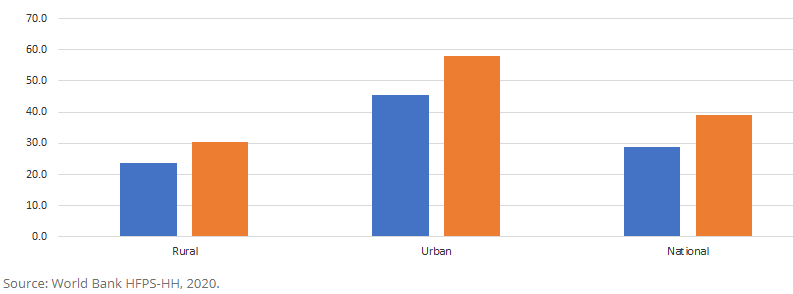OUSMANE DIONE
The COVID-19 (coronavirus) pandemic has reshaped the global economy and daily lives of people across the entire world. The World Bank’s most recent Poverty and Shared Prosperity Report shows the pandemic could push some 100 million people into extreme poverty in 2020 alone, and lead to an increase in global poverty for the first time since 1998.

In Ethiopia, infections are rising, with 89,860 confirmed cases as of October 19, 2020. While Ethiopia took several steps to keep COVID-19 infections low and mitigate its economic impact, it is still severely affected by the virus. Data obtained from high-frequency phone surveys (HFPS) of households and firms conducted on a monthly basis by the World Bank and the government since April has revealed the true effect of the pandemic on Ethiopia.
Impact on the economy
The COVID-19 pandemic has substantially affected firm operations. More than 42% of registered businesses in Addis Ababa completely ceased operations and 37% reported no revenues in March or April. Firms have since gradually re-opened, but data show that only 58% were open full-time, and about one-quarter were still closed in mid-September.
Firms are primarily affected by a significant fall in demand, resulting in exceptionally low revenues. Expectations for recovery remain subdued, with only 2% of firms expecting to immediately hire new workers. Lower revenues and subdued expectations will significantly affect economic recovery. The World Bank now estimates that growth in Ethiopia would be 4 percentage points lower than the pre-COVID-19 forecast.
Impact on households
The pandemic’s negative impact has resulted in reduced employment and household incomes. According to the surveys, more than half of households reported that their incomes were either reduced, or had totally disappeared in April 2020, with female-headed households being hit harder.
Employment rates plunged in the early days of the pandemic and are yet to fully recover, suggesting a persistent impact of COVID-19 on the volume of jobs, especially in urban areas. About 8% of respondents lost their jobs at the beginning of the outbreak. Job losses were higher in urban (20%) than in rural areas (3%) and higher for women (13%) than for men (6%). Most affected were the self-employed or those working as casual laborers in urban areas. Employment rates have since rebounded, but continue to remain lower than before the pandemic in urban areas (Figure 1).
Figure 1: Employment rates rebounded quickly, but remain lower than in the pre-COVID-19 era
(Share of respondents that are employed)

Employment rates rebounded quickly, but remain lower than in the pre-COVID-19 era
Source: World Bank HFPS-HH, 2020.
Urban household incomes declined most, primarily due to reduced demand which affected income generation from self-employment, wage-employment, and household enterprises. Among those with a household business, about three in five reported a reduction in business income. Real wages in Addis Ababa had declined by 14% and 3.7% for high and low-skilled workers respectively, in April 2020 compared to April 2019. These and similar challenges across the developed world led to a decline in domestic and international remittances. Nearly a fifth of remittance-dependent households have not received any since the onset of the pandemic. Growth in urban areas had been a key driver of poverty reduction in the recent past. The significant decline in incomes point to stalling of progress that had been made in reducing poverty in the short term.
There are some potential long-term consequences too. For example, existing inequalities could be exacerbated in schooling outcomes, particularly for girls already behind boys in upper primary and secondary education. Ethiopia’s rural and poor children have trailed their urban and richer peers in schooling outcomes, tending to drop out of primary school early, perpetuating the intergenerational transmission of poverty.
Since schools closed, most students had no opportunity to learn. Seven of every 10 primary students and six of every 10 secondary students had no opportunity to learn nationwide but, urban children were twice more likely to have a learning opportunity (figure 2). The long-term impact of lost months of schooling will be particularly severe for poor children, jeopardizing their ability to build human capital and affecting their future earning potential. The temporary school closures may lead to children from vulnerable households dropping out permanently, especially in rural areas, where even in ordinary circumstances early drop-out is rife.
Figure 2: Few children are engaged in learning activities during school closure
(Share of children who previously attended school who are engaged in learning activities, by type of education- June 2020)

Few children are engaged in learning activities during school closure
Source: World Bank HFPS-HH, 2020.
COVID-19 recovery
The pandemic poses formidable challenges for the country’s people and economy. Ethiopia’s achievements in poverty reduction of the past decade were based on strong economic growth and the government’s ability to provide public services to the poor.
The most urgent task is to boost job creation. Crucial to this are reforms to improve access to credit to the private sector, many of whom are facing a liquidity crunch as a result of months-long lack of revenue. The National Bank of Ethiopia has availed liquidity to banks to reprofile debt and provide additional loans, but these mostly benefited larger firms. Data suggest that none of the own-account businesses received loans they applied to while small, medium and large enterprises obtained only 8.5% of the loan amount they sought. Thus, government’s efforts need to extend to SMEs as well. This ensures continuity for businesses by making it easier for them to finance operations and invest in digital technologies to fast track adaptation to the new ways of doing business in the post COVID-19 world. Another important measure would be to implement temporary wage subsidies to prevent further reduction in wage incomes while keeping workers on the payroll. However, this only helps those in formal employment. Cushioning the impact on self-employed and casual laborers, through targeted social and employment assistance programs, is equally important. A good way to do so is by providing temporary jobs – for example, through public works as an extension of the productive safety nets programs.
For the future, recovering lost learning opportunities for children, especially girls, is of utmost importance, both for building a capable workforce and avoiding entrenchment of inequalities of opportunities. The first key challenge to address is ensuring all children can safely get back to school once they re-open and avoid permanent drop-outs. Second is facilitating catch-up learning to complete last year’s curriculum while ensuring high-quality education. Both issues require addressing long standing challenges in Ethiopia to reduce dropouts, facilitate school progression, and improve the quality of learning.
Ousmane Dione
World Bank Country Director for Eritrea, Ethiopia, South Sudan and Sudan
